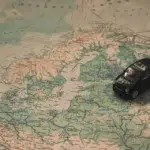Packing Toys and Games for a Move: How to Do It Right?
Moving is a demanding task in many ways. And like most things in life, it is harder to do if you have kids. The thought of packing everything from the smallest sock to the largest pieces of furniture is already nerve-wracking. However, have you ever thought about how to pack your children’s toys and games? Toys and games are not only valuable possessions. They also have sentimental value and can bring joy to your children during stressful times like relocations. Proper packaging of these items is important to ensure their safe transport and avoid any damage or loss. With the help of Best Cross Country Movers, we’ll provide advice on packing toys and games, as well as the importance of doing it right to make your move easier and less stressful for both you and your little ones.
First Things First – Sorting Through Before Packing Toys and Games
The first step in making everything easier to pack is sorting and organizing. Properly assessing and sorting toys during preparation for a move helps determine the usability and safety of toys and games. It lets you identify broken toys, missing parts, or age-inappropriate toys.

By organizing toys and games you can get rid of excess, give away something that no longer fits the child’s age, or recycle unusable toys. Proper sorting based on their size, fragility, and type also enables easier packing in boxes and prevents their damage. All of that will make the transition easier for the parent and the child.
What to do with toys that are not in use?
If you have a pile of unused toys cluttering up your home, consider donating to reduce the number of items you have to pack away. Inspect your child’s toys and determine which ones are still in good condition. Separate them into categories, such as board games, action figures, and stuffed animals for easier access during and after unpacking.
If you also have a lot of children’s books, pack them separately. This will make shipping and donating easier. Next, research local charities or organizations that accept toy donations. You can also check with schools, churches, or community centers. But be sure to check their donation policy and see if they have any special requirements. Once you’ve found a suitable donation location, pack the toys into shipping boxes. Label the boxes clearly and make a list of the items in them. This will help the charity or organization keep track of what it receives.
Donating toys not only helps reduce clutter in your home but also allows you to give back to your community. By donating toys that are no longer in use, you are helping to spread joy and happiness to children who may not have access to as many toys.
Gathering Packing Supplies for Packing Toys and Games
When it comes to packing toys and games, it is important to have the necessary packing materials to ensure safe and efficient transportation. Rigid boxes are the best choice. Opt for boxes that are durable and can support the weight of the item. Packing tape is important for securing boxes and preventing any potential damage, so invest in high-quality tape to ensure it doesn’t come loose during transport. Some toys also require bubble wrap. It will provide cushioning and protection for fragile items such as figurines or board game pieces. However, if you’re not in a position to buy all that packing material, there are places where you can packing materials for free. Additionally, you can get creative and use any sort of container that you can fin in your home.
Be sure to protect fragile toys and games
Fragile toys and games require extra care and protection during the packaging and shipping process. It is important to provide adequate cushioning to prevent damage. There are plenty of options and ways you can provide cushioning for the toys, starting with the most common – bubble wrap. Bubble wrap has small air pockets that can provide cushioning. It is lightweight and can be easily cut to fit any packaging size.

Packing paper is another option for cushioning. It is versatile and can be crumpled or wrapped around items. If you want to fill any space within the packaging, use the foam peanuts. Using all these materials will decrease the likelihood of damage and ensure that the items arrive safely at their destination.
Packing Strategies for Toys and Games
Disassembling large toys and games can be a tedious task, especially if you’re not sure where to start. However, breaking down these complex items can be extremely beneficial, as it allows for easier storage and transport. If you’re planning on taking apart a large toy, consider the following steps:
- Study the item’s construction and take note of any unique features.
- Take pictures of the item before disassembly for future reference.
- Ensure all necessary tools are within reach before you begin.
- Keep track of small parts, screws, and other pieces to avoid losing them.
- Properly label and organize disassembled components for easy reassembly.
By following these steps, you’ll be able to disassemble large toys and games efficiently and safely, making the storage and transportation process much more manageable. Remember, taking the time to plan and document the disassembly will save you headaches when it comes to putting everything back together.
How to avoid losing small parts and screws?
To avoid this problem, consider using labeled plastic bags to store each set of screws or parts. For example, if you’re taking apart a bicycle, you might have bags labeled “handlebar screws” and “pedal bolts.” These bags will keep your items organized and easy to find. Also, once you have labeled a plastic bag packed with miscellaneous small parts tape it to the box or to the packed toy or game to make sure it doesn’t get separated.
Organizing small toys
When it comes to organizing small toys, using compartmentalized storage containers or ziplock bags can be incredibly helpful. These options allow you to easily separate and sort different types of toys, making it easier to keep everything tidy and find what you need. Once you choose your storage method, it’s important to consider labeling the containers or bags. This simple step can make unpacking and organizing small toys much easier. Labeling can be as simple as writing the name of the type of toy on the container or bag. Also, you can create more elaborate labels with stickers or colorful markers.
Tips for effective labeling
Instead of just labeling a container “Toys,” consider breaking it down further. For example, you might have a container labeled “Cars and Trucks,” “Dolls and Accessories,” or “Building Blocks.” This makes it easier to find exactly what you need when you’re looking for it. If your child isn’t able to read yet, consider using pictures to label the containers or bags. Whatever labeling method you choose, be consistent throughout your organizing system. This will make it easier for both you and your child to remember where everything goes and find it quickly. The challenge of moving with children across the country is immense and it is important to plan every detail correctly.

Stacking and Securing Board Games
The first step in stacking and securing board games is choosing a sturdy container. Sort board games by size and weight. Smaller, lighter games should be packed on top of heavier games. It is also useful to use dividers or cardboard separators so that the games do not touch each other. This will prevent damage to the boxes and protect the game components inside. Wrap the boxes in bubble wrap or other protective cushioning to prevent scratches, dents, and other damage during shipping. Once all the games are packed, seal the container with tape and label it clearly.
Special Considerations for Electronic Toys and Games
When packing electronic toys, it is very important to remove the batteries. If batteries are left in toys and games during transport, they can leak and cause damage to electronic devices and even pose a potential safety risk. A leaking battery can cause corrosion to the contacts inside the device, which can cause malfunction or permanent damage. Safety cables and accessories must also be protected. Cables and accessories can easily become tangled or damaged during transport if not properly secured. To prevent this, it is recommended to use cable ties or small cable storage bags with suitable devices.
Unpacking and Reassembling Toys and Games
After moving into a new home coming reassembling and testing games. To reassemble disassembled toys and games, refer to the instruction manual or pictures for easy reassembly. Test electronic toys and games to ensure they are working properly by checking the batteries, connecting to a power source, and running a test game or function. This ensures that your children can play with their toys and games without interruption.

Packing Toys and Games for a Move can Be Done by Your Moving Company
As a responsible homeowner and parent, it is important to protect your children’s cherished possessions during the move. Following the tips outlined in this article will ensure that your toys and games arrive at your new home in the same condition as they were before the move. However, if packing toys and games seems overwhelming, consider hiring a professional mover to help you pack all your household items. Remember, proper packing is the key to a successful and stress-free move. So, take the necessary precautions and enjoy your new home to the fullest!





